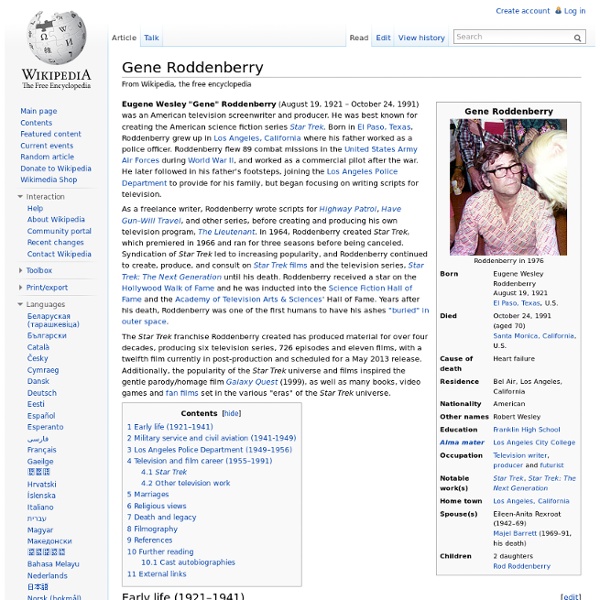



Star Trek Star Trek has been a cult phenomenon for decades.[1] Fans of the franchise are called Trekkies or Trekkers. The franchise spans a wide range of spin-offs including games, figurines, novels, toys, and comics. Star Trek had a themed attraction in Las Vegas which opened in 1998 and closed in September 2008. At least two museum exhibits of props travel the world. The series has its own full-fledged constructed language, Klingon. Several parodies have been made of Star Trek. Conception and setting The Starfleet emblem as seen in the franchise. Most Star Trek stories depict the adventures of humans[Note 4] and aliens who serve in Starfleet, the space-borne humanitarian and peacekeeping armada of the United Federation of Planets. Roddenberry intended the show to have a highly progressive political agenda reflective of the emerging counter-culture of the youth movement, though he was not fully forthcoming to the networks about this. History and production Beginnings Rebirth After Roddenberry Reboot
Majel Barrett Majel Barrett-Roddenberry (first name pronounced /ˈmeɪdʒəl/; born Majel Leigh Hudec;[1] February 23, 1932 – December 18, 2008) was an American actress and producer. She is best known for her role as Nurse Christine Chapel in the original Star Trek series, Lwaxana Troi on Star Trek: The Next Generation and Star Trek: Deep Space Nine, and for being the voice of most onboard computer interfaces throughout the series. She was also the wife of Star Trek creator Gene Roddenberry. As the wife of Roddenberry and given her ongoing relationship with Star Trek—participating in some way in every series during her lifetime—she was sometimes referred to as "the First Lady of Star Trek". She and Gene Roddenberry were married in Japan on August 6, 1969, after the cancellation of the original Star Trek series. They had one son together, Eugene "Rod" Roddenberry, Jr., born in 1974. Biography[edit] Star Trek[edit] Barrett as the original "Number One" in Star Trek: The Original Series first pilot episode
TrekMovie.com | the source for Star Trek news and information Main Page - Obsidian Fleet Database Star Trek: First Contact "Resistance is futile." Six years have passed since Captain Jean-Luc Picard was captured and assimilated by the Borg. Now, the Borg make a second attempt to conquer the Federation; but Starfleet believes that Picard's experience makes him an "unstable element to a critical situation" and orders him to stay behind. But, when Starfleet's fight does not go well, Picard and the crew of the new USS Enterprise disobey orders to join the fight, following the Borg three hundred years into the past just as Zefram Cochrane prepares to launch Humanity's first warp-capable engine, the Phoenix, and make first contact with an alien race. Summary Edit Act One Edit 24th century Edit Lieutenant Commander Worf, commander of the Defiant, arrives on the bridge and offers assistance. 21st century In the small shanty town of Bozeman, Montana, Lily Sloane and Zefram Cochrane wander out of a makeshift bar as their town is unexpectedly pulverized by a volley of disruptor fire. Act Two
Timeline Series and movie settings[edit] This table shows each TV series and movie, its year of release or broadcast, the year it was set in, according to the prevailing Okuda chronology (see below) and the stardate range for that year. The designation Enterprise-based series are the series that featured the various incarnations of the starship USS Enterprise. In universe timeline chronological order Star Trek Enterprise (ENT), Star Trek: The Original Series (TOS), Star Trek: The Animated Series (TAS), Star Trek: The Next Generation (TNG) and all 12 of the Star Trek feature films including the two newest J.J. Timeline[edit] This timeline is based on the Star Trek Chronology model described below, supplemented by data from startrek.com.[5] Note: Many of these dates are rounded-off approximations, as the dialog from which they are derived often includes qualifiers such as "over," "more than," or "less than." Thousands, millions or billions of years ago[edit] 1st millennium[edit] Pre-20th century[edit]
Star Trek: The Original Series The show is set in the Milky Way galaxy, roughly during the 2260s. The ship and crew are led by Captain James T. Kirk (William Shatner), first officer and science officer Mr. Space: the final frontier. The series was produced 1966–67 by Desilu Productions, and by Paramount Television 1968–69. Creation and development[edit] In 1964, Gene Roddenberry, a longtime fan of science fiction, drafted a proposal for a science-fiction television series that he called Star Trek. Some of the influences on his idea that Roddenberry noted included A. The second pilot introduced the rest of the main characters: Captain Kirk (William Shatner), chief engineer Lt. Production[edit] The original starship Enterprise The show's production staff included art director Matt Jefferies. Season 1 (1966–67)[edit] William Shatner as Kirk in action, from the episode "Where No Man Has Gone Before", 1966 I am an avid fan of Star Trek, and would simply die if it was taken off the air. Season 2 (1967–68)[edit] Look! and
Dwight Schultz Cully Fredricksen Patti Yasutake Jack Shearer Patrick Stewart In 1993, TV Guide named him the best dramatic television actor of the 1980s,[1] and television's sexiest man in the previous year.[2][3] Early life[edit] Patrick Stewart[4] was born on 13 July 1940[5] in Mirfield,[6] in the West Riding of Yorkshire, England. He is the son of Gladys (née Barrowclough), a weaver and textile worker, and Alfred Stewart, a Regimental Sergeant Major in the British Army. He has two older brothers, Geoffrey (b. 1925) and Trevor (b. 1935).[7][8] I believed that no woman would ever be interested in me again. Patrick Stewart, Regarding his becoming bald as a teenager[12] Stewart attended Crowlees Church of England Junior and Infants School.[13] He attributes his acting career to an English teacher named Cecil Dormand who "put a copy of Shakespeare in my hand [and] said, 'Now get up on your feet and perform'".[14] In 1951, aged 11, he entered Mirfield Secondary Modern School,[15] where he continued to study drama. Career[edit] Early work[edit] Stage[edit]